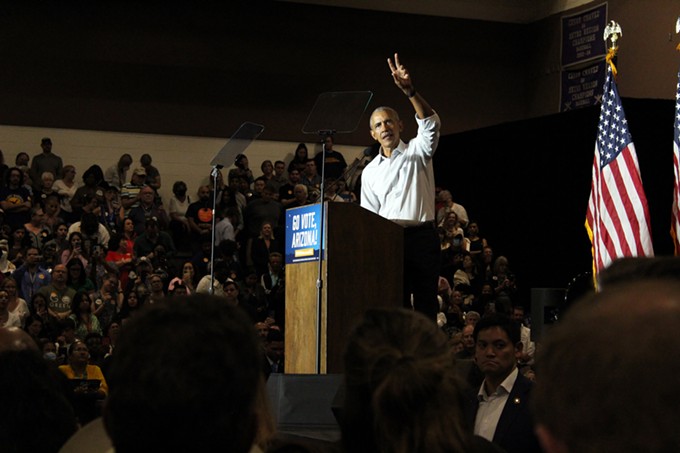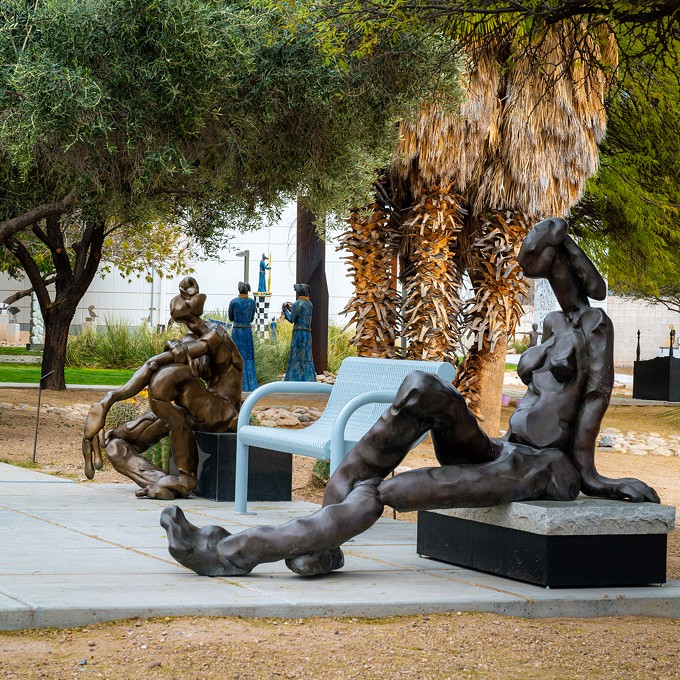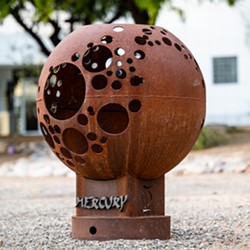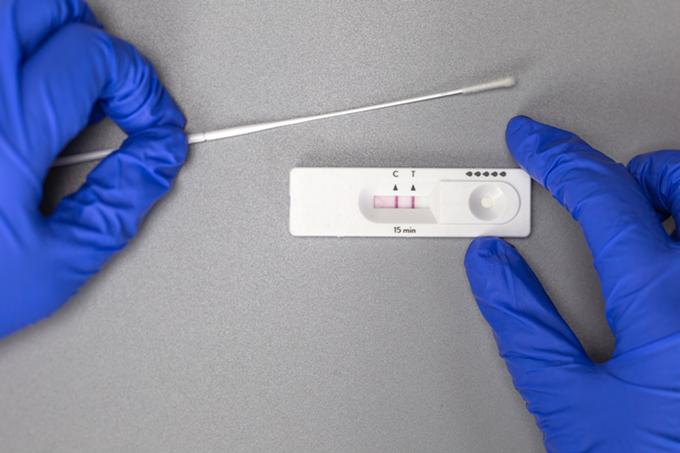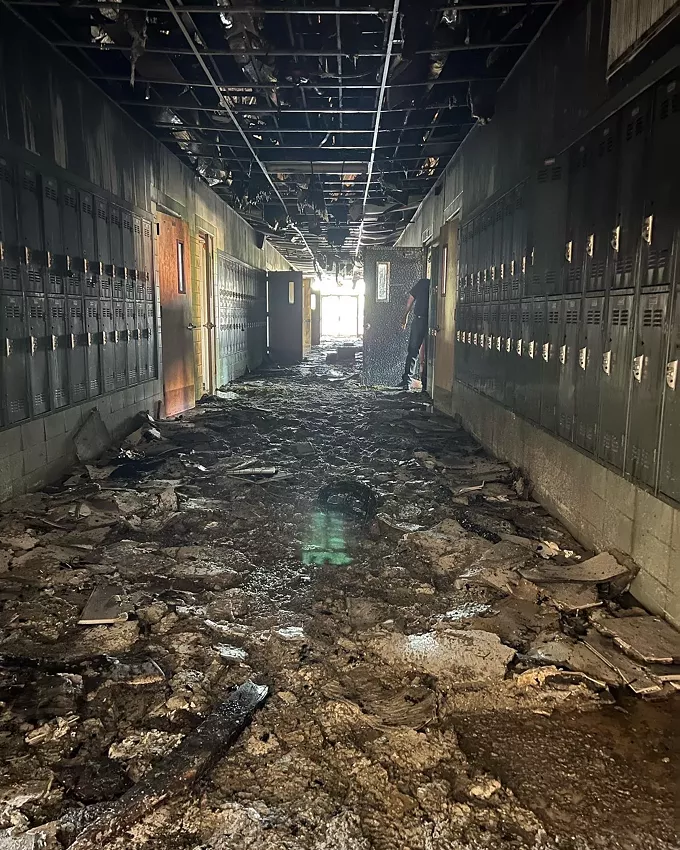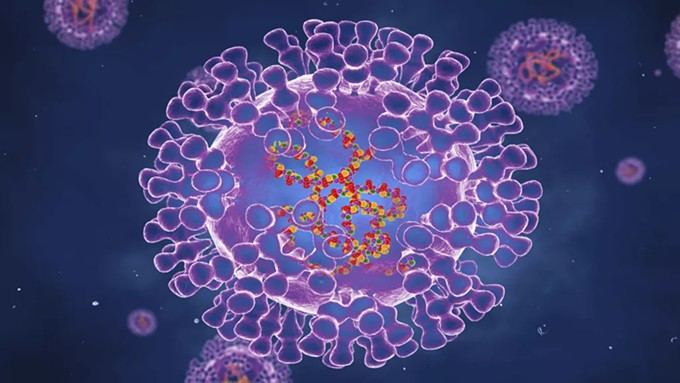Monday, November 7, 2022
Former President Barack Obama traveled to Phoenix to stump for Sen. Mark Kelly of Tucson and gubernatorial candidate Katie Hobbs, the current secretary of state, at Cesar Chavez High School in Phoenix on Nov. 2, ahead of midterm Election Day.
The high school gymnasium housed a standing-room-only crowd of over 1,000 people, who were electrified by the former president’s candor with his father-like wisdom and calming presence.
Obama endorsed the candidates and forewarned Arizona voters about the future of democracy in the swing state.
“Consider the fact that our democracy is on the ballot, and nowhere is that clearer than here in Arizona,” Obama said.
The 44th president denounced far-right conspiracy theories espoused by many of the GOP candidates, including gubernatorial candidate Kari Lake and Senate-seat hopeful Blake Masters, who support the “Big Lie” concerning the fraudulent results of the 2020 election.
“When we have politicians and elected officials in leadership positions who continue to promote over the top rhetoric, or at least ignore it or make light of it,” Obama said. “When you’ve got elected officials encouraging supporters to stand outside of voting places armed with guns and dressed in tactical gear, more people are going to get hurt.”
Hobbs, who is running against Lake, also asked voters to defend democracy, noting it was nice to be in a room full of people who were focused on the upcoming election instead of the last one.
“In a democracy, we all get a say in our future,” Hobbs said. “When we prove the government can help solve problems, we prove that democracy works.”
A social worker by training, Hobbs said she helped run one of the largest domestic abuse shelters in the country. That experience led her to seek out and address the issues that led people to these situations and she ran for office.
“In the Legislature I worked with both parties, to expand health care to over 500,000 Arizonans,” Hobbs said.
She also worked “across the aisle” on tackling the opioid epidemic within the state and working with the governor’s office to clear the state’s rape-kit backlog.
“That’s exactly the same kind of leadership that I will bring to the governor’s office,” Hobbs said. “Real solutions.”
Former Rep. Gabby Giffords also spoke on behalf of her husband, Kelly, and his re-election campaign. Giffords spoke about the importance of the election, lowering prescription drug costs, raising middle class wages, as well as protecting Medicare and Social Security.
“Mark focuses on facts, not politics, is caring and has already served our country in so many ways,” Giffords said. “We need him in the senate.”
Kelly, who served 25 years as a Navy combat pilot and later a NASA astronaut, won a special election in 2020 against Republican candidate Martha McSally,
“None of this would be possible without Gabby Giffords,” Kelly said.
Kelly advocates for revitalizing Arizona’s economy by lowering costs such as prescription drug costs, bringing back manufacturing jobs to the state, boosting renewable energy and creating well-paying jobs that do not require a four-year degree.
Kelly also condemned Masters for calling abortion “demonic” and for questioning the results of the midterm elections, ahead of Election Day.
“I’ve flown in combat 39 times, and I’ve flown in space four times, but never once did I do that by myself; it was always as part of a bigger team,” Kelly said, before thanking his constituents.
“The only way to preserve our democracy is if we together nurture and invest in it,” Obama said. “That starts by electing people who know you.
Tuesday, November 1, 2022
Hughes Federal Credit Union invites residents to shred sensitive, personal documents at the Leman Academy of Excellence in Marana and bring unwrapped gifts for infants and children hospitalized at Banner Diamond Children’s Medical Center on Saturday, Nov. 5, 2022, 9 a.m. to 1 p.m.
Participants may bring up to 15 pounds or three boxes of documents for each donated item and enter to win a $100 Visa® gift card. The most-needed toys include small-to-medium-sized stuffed animals, Legos, Uno cards, burst-resistant stress balls, light spinners, Pop Its, infant toys, small packs of Diamond toys, Fidget toys and activity kits.
“We are thrilled to give our community the opportunity to both protect their personal information to avoid identity theft and support local hospitalized children in need,” said Hughes’ President Robert J. Swick.
Hughes recommends shredding financial statements, tax returns, medical bills, photographs, credit applications, insurance records, checks, employment applications and credit card receipts. No cardboard or other media types such as electronics and batteries, magazines and books, CDs, DVDs and magnetic media, common trash or plastics are accepted.
“We greatly appreciate the community donation of gifts for hospitalized children," Chad Whelan, chief executive officer of Banner University Medicine, said. "The generosity demonstrated through the donation of gifts truly brightens the spirit of families experiencing difficult times."
Wednesday, October 19, 2022
The Tucson Jewish Community Center (the J or the Tucson J) presents “A Celebration of Sculpture,” Sunday, October 23 from 10 a.m.-1 p.m. The free, all-ages annual showcase features a juried outdoor exhibition with eight new sculptures joining the SculptureGarden’s existing collection of over 40 works by local, national and international sculptors, an indoor Fine Art Gallery opening with more than 20 sculptures from 12 local artists, artist talks and live music throughout the duration of the event, dance performances from ZUZU! DanceGroup and Esperanza Dance, activities by Ben’s Bells and Arts for All (a Tucson J program) for all ages and abilities, and delicious kosher pizza for sale from the Kosher Pizza Truck.
Jurors Darlene Kryza, Donna Isaac, and Hirotsune Tashima selected the works for the juried exhibition, which includes sculptures by Pamela Ambrosio, Curt Brill, Gedion Nyanhongo, Hector Ortego, Joan Waters, and Nan Wollman. Artists exhibiting in the Fine Art Gallery show include Pamela Ambrosio, Jesse Berlin, Steve Grater, Candace Greenburg, Jerry W. Harris, Ronald Kalinoski, David Knorr, Andree Richmond, Gerald Rockwell, Ellen Sidor, Ted WadeSpringer, and Nan Wollman.
The three-hour event features live music indoors and outdoors by harpist Rebecca Foreman, pianist Sarah Tolar, guitarists Leila Lopez and Nathaniel Burnside, the Christine Harper FluteDuet, and Stu Mellan and the Birks Works Jazz Quintet.
In 2009, the J established its Sculpture Garden with a four-fold purpose in mind: to craft a public space that celebrates the appreciation of sculpture; to create an atmosphere of tranquility; to promote educational opportunities; and to enhance community fellowship. The convergence of art and audience in the Sonoran Desert region encourages visitors to relax, converse, meditate, and contemplate. The landscaped garden showcases outdoor sculpture, offers views of the surrounding mountain ranges and provides a meditative environment within the city limits.
A dedicated team of volunteers and lay leaders make up the J’s Sculpture Garden Committee, working in tandem with Jennifer Selco, the Director of Jewish Life and Learning, to oversee the planning and logistics of both the space and the annual event.
“I am very proud to be part of bringing new artists and their sculptures each year to the J’sbeautiful and peaceful garden in the heart of Tucson—a splendid public space to showcase 40world class sculptures for the entire year by some of America’s leading artists, a welcoming place where the entire Tucson community can celebrate the art and the artists who create such outstanding sculpture,” says Raymonde Zlotnikoff, sculptor and Chair of the J’s SculptureGarden Committee.
The Tucson J believes that arts and culture are critical means by which its community understands and appreciates itself more deeply and truly, offering experiences through a variety of mediums including visual art to foster conversations rooted in shared understanding, give new perspective to the most important questions of the world today, and promote creativity across the ages.
"I believe the J’s Sculpture Garden is on the cusp of becoming one of the most important cultural destinations in Tucson," added Claire West, Sculpture Garden Committee member.
“I have shown work in galleries for many years. The work I display outside has the same sense of intimacy as my ‘inside’ work; it can feel vulnerable to exhibit in the grand scale of a public garden. I am grateful for the opportunity the J is giving me to make this step with my sculpture, The Green Splitting Tree. I think the placement shows the piece well, giving it scale, and intimacy,” says Nan Wollman, who is exhibiting work in both the Sculpture Garden and Fine ArtGallery.
Thursday, October 6, 2022
Professor Thomas Meixner, 52, was shot and killed on the University of Arizona’s main campus Wednesday, Oct. 5, by a former student.
Meixner, who was known for his work in arid and semi-arid hydrology and water quality, was the department head of hydrology and atmospheric sciences.
“This incident is a deep shock to our community, and it is a tragedy,” said UA President Robert C. Robbins in a press release. “I have no words that can undo it, but I grieve with you for the loss, and I am pained especially for Tom’s family members, colleagues and students.”
UA Police responded to a phone call at 1:59 p.m. about a person who entered the John W. Harshbarger Building which houses the department of hydrology and atmospheric sciences, said Paula Balafas, UA Police Chief during a press conference Wednesday afternoon. UAPD did not disclose who the caller was.
The caller reported that the “former student” wasn’t allowed to be in that building and wanted UAPD to escort them out.
“It was someone who was known to the staff member, as a former student and they believed that he should not be in the building.” Balafas said. No further details have been provided about why the student was barred from the building.
While UAPD was “en route,” they received an additional report that someone had been shot inside of the Harshbarger building. At 2:06 p.m. they received an additional report regarding that same shooting and at 2:07 p.m., the reporting party had reported that the suspect had fled the scene, Balafas said.
The suspect reportedly ran out of the main doors to the Harshbarger building.
“At 2:13 p.m., Tucson fire personnel arrived at the scene to treat one victim who had been shot and that person was transported to Banner University Medical Center,” Balafas said. “Unfortunately, in the emergency room that victim was pronounced deceased by medical personnel.”
UAPD sent out an alert at 2:17 p.m. notifying those on campus about a shooting at the Harshbarger building, stating to stay away from the surrounding area and again at 2:28 p.m., about the male suspect who was no longer at the scene. The suspect was described having a “dark complexion, 5ft8in tall, around 35yrs, short brown hair, wearing Blue Baseball cap, and dark backpack,” four minutes later.
Non-essential faculty, staff and students were asked to leave campus or go to their residency halls at 3:46 p.m.
During the press conference, Balafas said that UAPD had identified the suspect, Murad Dervish, 46, who had been taken into custody at 5:10 p.m. by the Department of Public Safety, after a traffic stop 120 miles outside of Gila Bend.
UAPD released an “ALL CLEAR” notification at 5:28 p.m.
Dervish, was a former graduate student in the department of hydrology and atmospheric sciences. Balafas said that she did not know the history between Meixner and Dervish prior to the shooting. Dervish had been evicted from a guest house in the West University neighborhood just last week, the Tucson Sentinel reported.
“We received quite a bit of regional assistance today, primarily from the Tucson Police Department who was assisting us at the scene and with the investigation,” Balafas said.
Assistance was received from the Bureau of Alcohol, Tobacco and Firearms and the Pima County Attorney’s Office and their victim advocates who responded both at the scene and hospital to speak with witnesses, Balafas said.
UAPD did not release the victim’s name during the press conference, Balafas said that, “that can come from the hospital or the coroner’s office.” UAPD was the lead agency on the case.
Afternoon classes, events and activities were canceled for the remainder of Wednesday afternoon, and were to resume on Thursday, Oct. 6, unless noted otherwise by instructors.
“I encourage you to have compassion for one another and to care for yourselves and those around you during this difficult time,” Robbins said.
The UA created a webpage after the incident with information relating to the shooting, additionally containing resources to Counseling and Psych Services, Employee Assistance Counseling and Life and Work Connections.
Meixner is survived by his wife Kathleen and sons, Brendan and Sean, as well as the grieving UA community.
This year also marks the 20th anniversary of the murder-suicide that occurred at the UA College of Nursing on Oct. 28, 2002, when a failing student shot and killed three professors before taking his own life.
Wednesday, August 3, 2022
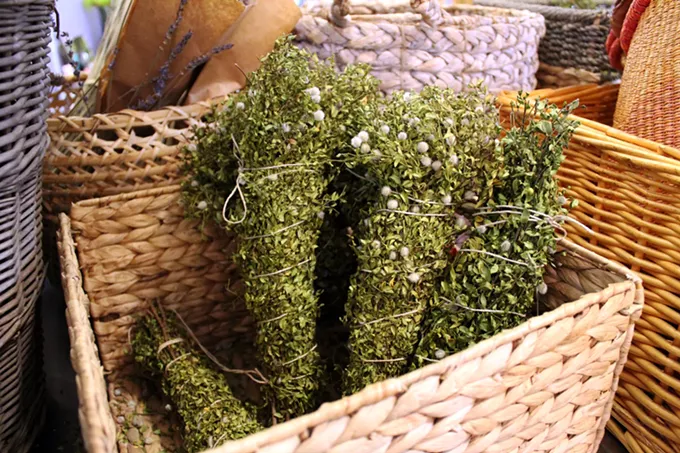
Monsoon season in Tucson, which lasts from mid-June to late September, is a special time for locals. It provides desert inhabitants with the euphoric sense of biophilia, or innate instinct to connect with the natural world around them.
“The theory is that when you’re looking at these beautiful views and plants, you’re giving yourself a shot of feel good molecules,” said Dr. Esther Sternberg, a University of Arizona researcher who studies the mind-body interaction with its natural and built environments.
The rains can trigger a relaxation response and reduce stress hormones. Certain integrative health behaviors, such as walking outside and inhaling the creosote bush, for example, are posed to change anti-stress brain pathways.
The shrub, which is found in the Southwestern region of North America and most commonly in the Sonoran, Mojave and Chihuahuan deserts, is also known as greasewood or chaparral. Creosote is often credited for the earthy fragrance that emits during monsoon season. It has also been said to have existed since the beginning of time, according to the Tohono O’odham creation story.
According to the O’odham, Shegoi was the first plant that Tcuwut Makai, the Earth-Maker, created.
“It is the greatest, highest, most sacred plant we have that inspires the strongest medicine,” said Camillus Lopez, senior cultural mentor at Tohono O’odham Community College (TOCC).
Lopez, who teaches Tohono O’odham studies courses, is on the Himdag Committee that oversees TOCC students’ growth in cultural knowledge.
The plant has been historically linked to a variety of homeopathic remedies for various ailments such as chest infections, intestinal discomfort, venereal diseases and more. There are even claims it treats cancer. While it has been advised the plant should not be consumed for extended periods of times, its antibacterial properties have found their place in homeopathic remedies.
Local business owner and herbalist-in-training Rosie Crocker, founder of Sonoran Rosie, noticed an absence of desert plants in the herbalism world. An essentially “white-washed” European field, she noticed the lack of natural products sourced from the Sonoran Desert and decided to create sustainable herbal beauty products of her own.
“I want to be respectful to the heritage of the plants that are here,” Crocker said. “I use them in ways that have never been used before.”
Her products use desert herbs for aromatherapy and wellness purposes.
“Although I believe that plants are autonomous, I believe that just like food we can all participate in a relationship with plants,” Crocker said. “It’s always good to be respectful of people’s culture and not just try to capitalize off of a traditional way of making something.”
In addition to making everyday essentials such as deodorant, lip balm or lotions, her naturally sourced products smell like rain.
Creosote is one of her primary ingredients. She said it has a calming, grounding and protective effect. “They have traced back a root system to (about) 11,000 years old and to me that feels like it has that energy of being ancient, tenacious and super healing,” Crocker said.
According to researchers, the volatile organic compounds found in desert plants are good for our health. Gary Nabhan, a research social scientist at the University of Arizona, said the oils desert plants exude as systems are highly potent, like a “symphony orchestra of fragrances.”
Nabhan, who recently celebrated the 40th anniversary of his book “The Desert Smells Like Rain,” has a background in agricultural ecology and ethnobotany. He said he was inspired by a young O’odham student who identified the paradox of the desert’s perfume.
He set out on a scientific mission to address why the desert smells the way it does. The debate between scientists has gone on since the 1930s. While geologists felt the soil crust on the surface of the desert made up of fungi, algae and cyanobacteria emitted fragrances when it rains, botanists have argued the creosote bush is responsible. Botanists used its 35 potent volatile oils as evidence. “The kinds of hazes and desert mirages we see when we look across large distances of the desert are from one of those volatile chemicals and creosote bush called isoprene,” Nabhan said.
Nabhan and his collaborators identified 115 volatile organic compounds in at least 60 plant species in the Sonoran Desert that are released when it rains. At least 15 have been found to offer “tangible” health benefits like improved sleep, heightened mental clarity or stabilized emotional-hormones. Evidence also showed some of these compounds are released at the onset of rain, when there’s an increase in humidity or stronger winds. Once released into the atmosphere, the compounds travel into our lungs and enter the bloodstream.
“When we get a summer monsoon rainstorm, we have a barometric pressure change, a change in wind speed and ferocity (and) sometimes wind direction changes that make us more receptive to these things because our senses are hypersensitive to ozone changes,” Nabhan said.
“Even when it’s not raining on a hot day in June, the creosote are giving off a gas,” Perry Grissom, a restoration ecologist at Saguaro National Park, said. “You can smell them before the rain comes.”
While scientists and indigenous practitioners have known the health benefits of ingestion or even absorption of Sonoran Desert flora, other integrative practices such as forest bathing have become mainstream.
“It’s immersion,” Grissom said. “Stopping, smelling, seeing, letting the desert wash over (you).” Practitioners like Dr. Lee Ann Woolery, an interdisciplinary educator, researcher and artist, developed the practice of art-based perceptual ecology. Woolery held workshops teaching the traditional Japanese practice of, shinrin-yoku, amongst the giant saguaros.
“This fact that we’re out breathing good air, the same air that the cactus are (transpiring) can be a health benefit,” Woolery said. “Coming to be one with the landscape is one of the ways I describe it.”
Her work blended art, ecology, and connected people to the environment. Using her own developed “methodologies,” the core of Woolery’s work exists at the intersection of art and natural science research.
“We’re engaging in multi-modal knowledge systems, (which) means there are many ways of knowing our local habitat, plants, herbs or whatever you’re studying,” Woolery said. She said she feels like her methodologies align more with traditional ecological knowledge than Western science.
Traditional ecological knowledge is the ongoing practice or learning of the relationships between living beings in a specific ecosystem, commonly acquired by Indigenous people over time.
A similar practice can be seen in TOCC’s Himdag curriculum, which teaches students the Tohono O’odham culture, values and way of life. The tribal college requires students to learn some of the language, history and culture from the “beginning” to the 1980s. Certain events at the college revolve around the O’odham seasonal calendar.
The old way of the calendar, according to Lopez, would follow the sun, moon and stars’ placements in the sky. For centuries O’odham people could predict the weather or know when to harvest crops with this knowledge.
For example, Jukiabig, or July, is the month of big rains. Months, which are considered to be more like seasons, follow cactus growth.
“In the traditional myth, there’s a story about how the cactus was born,” Lopez said. Depending on the watershed area and when cactus flowers begin to bloom and gather fruit, or bahidaj, marks the beginning of a new season and new year.
“The saguaro cactus fruit used to be the foremost thing in our culture, to make bahidaj and to make navai’t (cactus wine) because they wanted rain,” Lopez said. “Life centered around the saguaro fruit.”
Juk, or rain, is the most sacred thing in the desert. It is a cause for celebration for other cultures as well. Annually in Tucson, locals who live in the Menlo Park neighborhood host the Dia de San Juan Fiesta, or feast day for Saint John the Baptist on June 24. The celebration has occurred by the Santa Cruz River for at least 25 years. Liza Grant, the program’s coordinator, took over the celebration after her mother passed.
“Without water that area could not be ‘the birthplace of Tucson’,” Grant said in an email. “The [celebration] honors the 4000 years of continuous habitation along the river and the food raised by each culture.
The tradition marks the beginning of monsoon season.
Protecting Native Species
Grissom, who studies invasive plant species in the Rincon District of Saguaro National Park, said certain plants come out of their dormant state during monsoon season faster than native plants, stealing their water supply.
Places such as A Mountain have been overrun by buffelgrass. This invasive species posed a fire risk and completely demolished the saguaro population, Grissom said. “You can see the future if you don’t do anything.”
Saguaro National Park hosts ongoing volunteer buffelgrass removal parties such as Second Saturday in the Rincon District or Fourth Saturdays in the Tucson Mountain District which incentivize park goers with one-day passes for helping. Weed Free Trails Program teaches volunteers a variety of skills and Wilderness Volunteers invite visitors to camp at the park for a week. The park will also launch their Adopt-an-Area program this fall and will be installing boot brush stations with signs at trailheads over the next couple years.
Grissom has been at the park since 2006. He said his favorite-smelling desert plants are odoras, desert lavender and dalea to name a few. When the winds are thrashing about the desert, he said it smells like a “savory stew.”
“Currently we have that smell when it rains in the desert, but it doesn’t mean it’s guaranteed to be that way in the future,” Grissom said.
The truth can be found on A Mountain where the existing plant population has been reduced to sick saguaros, “a few scraggly plants of some kind,” and buffelgrass, which gives off a different smell than the “desert rain” most admire.
“[The Desert] is not guaranteed to be here,” Grissom said. “I just don’t want to be the guy on duty when the saguaros get wiped out at Saguaro National Park.”
Desert lovers can learn more about how to take care of the land and plants here nps.gov.
Monday, August 1, 2022

The Tucson Police Department announced an arrest over the weekend of 26-year-old Forrest Harris in connection to the Salpointe Catholic Fire that occurred on Sunday, July 17.
TPD responded to a call on Saturday, July 30, over a dispute about a dog, near North Country Club Road and East Grant Road and were able to identify and locate Harris due to an internal “stop and arrest”. A stop and arrest means there is enough probable cause to make an arrest.
After interviews, TPD found further probable cause to arrest Harris and officially charged him with arson of an occupied structure and booked him into the Pima County Jail. He was also charged with third-degree burglary and criminal damage.
Based on forensic evidence that was collected by Tucson Fire Department investigators at the fire scene, blood DNA connected Harris to the fire, according to Sergeant Richard Gradillas, spokesman for TPD.
“Our investigators did a lot of work to identify various ignition sources and sent off samples to labs to analyze where that fire might have started,” Michael Colaianni, spokesman for TPD said. Investigators handed over evidence and samples to TPD’s arson investigator who was able to make the arrest, Colaianni said.
The fire, which began in the attic space in the 700 English wing on the southeast corner of campus, destroyed six classrooms and will have to be rebuilt.
On July 21, school officials announced in a press release that the first day of school would be postponed by one week “in order to guarantee a safe and fully operational campus.”
“When the students come back on August 15, all of the classrooms will be functional with the exception of six classrooms and held in high-quality modular units that will [temporarily] work as our classrooms,” said Jennifer Harris, director of advancement at Salpointe Catholic High School.
The high school is going through the restoration process of smoke, water and electrical damages that were found throughout the 300 and 400 wings on the northeast side of campus and estimates the damages to be in the millions of dollars.
Monday, July 25, 2022
The Pima County Health Department announced the extension of the free COVID-19 Test to Treat program at the county’s East Clinic on Friday, July 22.
The program, which provides testing and access to treatment for COVID-19, in partnership with the Federal Emergency Management Agency (FEMA), will now run through Wednesday, August 24, based on public response.
“We still see a need in our community, and we’re happy to continue to make this free resource available,” Pima County Health Department Director Dr. Theresa Cullen said in a press release.
Individuals who have tested positive from an at-home test, testing site or at the clinic will be evaluated by a health care provider to determine their eligibility for antiviral medication for COVID-19 or can call the clinic at 520-724-7895 to determine eligibility.
Those who qualify will immediately receive a prescription at no cost and health insurance is not required.
The medications that will be available with a prescription are Pfizer’s Paxlovid and Merck’s Lagevrio. Both medications, when taken within five days of symptoms, are effective against COVID-19. As of July 20, Pima County had started 773 people on the oral medication, Paxlovid.
The two oral medications are also available at pharmacies within the county and can be prescribed by health care providers.
Those eligible for treatment are over 12 years old, weigh at least 88 pounds, have mild to moderate symptoms and have a high risk of severe COVID-19 illness.
Other Test to Treat sites are available locally at some pharmacies and federally-supported health care centers.
The East Clinic is located at 6920 E. Broadway Boulevard, Suite B. Hours of operation are now from 8 a.m. to 5 p.m. The Test to Treat program will not be available on the weekends. The clinic will open at 1 p.m. on Monday, July 25.
For more information about the Pima County Health Department Test to Treat program visit, pima.gov. For more information on where to get tested for COVID-19 in Pima County, go to pima.gov/covid19testing.
Wednesday, July 20, 2022
Significant damage has been reported at Salpointe Catholic High School, after a fire broke out on Sunday evening.
The Tucson Fire Department was dispatched at 8:09 p.m. to the southeast corner of the school, and arrived on scene by 8:13 p.m. Units from Station 5 observed “heavy smoke and flames,” TFD wrote on Twitter. A second alarm was called shortly after, fighting the fire defensively and controlling the two-alarm fire by 9:12 p.m.
The fire began in the attic space in the 700 English wing, on the southeast corner of campus. Smoke and water damage were also found throughout the 300 and 400 wings, along North Cherry Avenue, on the northeast side of campus.
There were no injuries reported and the cause of the fire is still unknown.
Fire safety assessment personnel and building safety experts were on campus Monday, July 18, to investigate.
The high school campus is closed until further notice, canceling all activities school officials said in a news release, but anticipates to start the school year on time on Monday, August 8.
TFD spokesman Michael Colaianni said the investigation is still underway, as samples will be taken for analysis.
Wednesday, July 13, 2022
The Pima County Health Department announced its first probable case of monkeypox during a July 12 press conference. Arizona’s first reported case was reported more than a month ago in Maricopa County.
Pima County Health Department Director Dr. Theresa Cullen said the infected person has been isolated and Pima County epidemiological staff are working on contact tracing.
The case is still under review by the Centers for Disease Control and Prevention and is believed to be considered low risk to the general population.
The Centers for Disease Control and Prevention recommends watching for early monkeypox symptoms such as fever, chills, headache, swollen lymph nodes, muscle aches and/or exhaustion. A rash or sores can also appear before, after or during symptoms. Antiviral treatment is available upon infection. Consultation with a health care provider is recommended if early monkeypox symptoms are exhibited.
“The most common route of transmission is skin to skin,” Cullen said. “You can transmit monkeypox by having direct skin to skin contact with a lesion.”
Until lesions are 100% scabbed, which takes between 14 and 21 days, people are infectious. Cullen said the chances of an individual becoming infected with monkeypox without having direct contact with an infected person are miniscule.
“Arizona has one confirmed and seven other probable cases pending confirmation from the Centers for Disease Control and Prevention, all of them in Maricopa County,” said Arizona Department of Health Services statement.
Maricopa, Coconino and Pima counties will become “hubs” for monkeypox vaccine distribution.
Pima County will receive about 100 vaccines for monkeypox treatment by Thursday, July 14. The vaccines are a two-dose series and individuals who consider themselves at risk can enroll on a Pima County website. The website will ask for demographic information, and a county representative will call to assess if the individual is at risk and requires a vaccine.
Those who share sheets, towels or unwashed clothing with those who have been infected are at risk. There is a slight chance of contact with prolonged respiratory secretions and face-to-face contact over four to six hours, Cullen said.
Men who have sex with men have been found to be the highest risk group for monkeypox, but not all cases that have been identified as such.
Although no one in the United States has died from monkeypox, a few individuals have been hospitalized primarily due to side effects such as secondary skin infection.
Individuals who believe they are at risk for monkeypox should reach out to their primary care providers or epidemiologists at the northside Pima County Public Health Clinic. For more information about monkeypox visit, pima.gov.
Coronavirus in Pima County
Coronavirus is in a stage of accelerated transmission.
“The vast majority of our COVID right now is the BA.5 variant,” Cullen said. “We are seeing a resurgence of respiratory symptoms.”
Reported cases fluctuate between BA.4 and BA.5 variants, the BA.5 being more predominant.
Pima County recommends vaccinations and two booster shots. Officials also said to wear masks in public or social settings.
Individuals who have tested positive for COVID-19 are eligible to receive treatment at the Pima County Health Department’s Test To Treat program located at its East Clinic, 6920 E. Broadway Boulevard. The program launched over two and a half weeks ago in partnership with the Federal Emergency Management Agency and provides testing and access to antiviral medications for COVID-19 at no cost. Health insurance is not required. The oral medications, Pfizer’s Paxlovid and Merck’s Lagevrio, are available and effective against COVID-19.
For more information about the coronavirus, monkey pox or the Pima County Health Department Test to Treat program visit, pima.gov. Visit pima.gov/covid19testing to find testing locations in Pima County.Tuesday, June 28, 2022
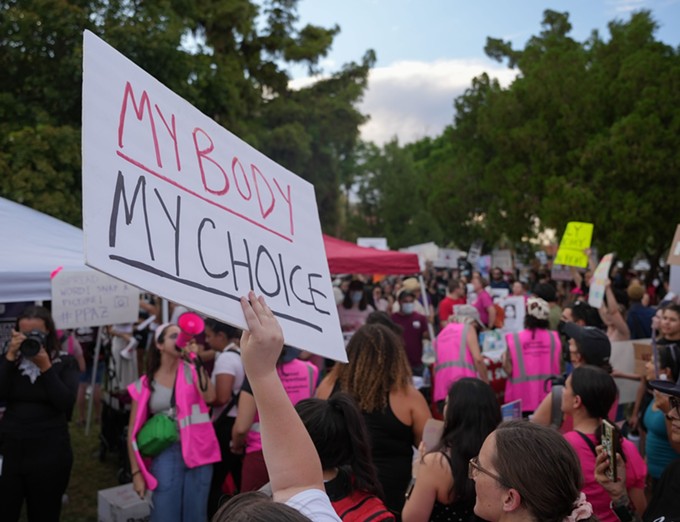
PHOENIX – In the wake of Friday’s U.S. Supreme Court decision to overturn Roe v. Wade – eliminating the constitutional right to an abortion – Planned Parenthood Arizona announced it has shut down its abortion services, effective immediately, while it sorts through “Arizona’s tangled web of conflicting laws.”
Abortion opponents, meanwhile, said “life has won a great victory.”
“We are working diligently with our team of attorneys to understand Arizona’s tangled web of conflicting laws so we can ensure that our patients know what their rights are and how to access legal abortion,” Brittany Fonteno, president and CEO of Planned Parenthood Arizona, said at a virtual news conference Friday.
The ruling, Fonteno said, will “serve to further our country’s disgraceful legacy of racism and discrimination, because it will have the greatest impact on Black, Indigenous, Latino and other people of color, young people and rural communities.”
She urged Arizonans to protest the court’s 6-3 decision.
“We have never before lost a constitutional right in the history of this country,” Fonteno said.
Thousands of protesters heeded the call and gathered at the Arizona Capitol on Friday night. Many carried signs decrying the Supreme Court’s ruling, with messages such as “My Body, My Choice,” as well as many more strongly worded messages. The crowd marched around the Capitol ground chanting, “Abortion is our right. We won’t give up this fight,” and other abortion-rights messages that had been distributed on small cards, and members of several groups, including event organizers Planned Parenthood, the Party for Socialism and Liberation and Radical Women, shared their frustration with the ruling.
But the activists were met by a smaller group of abortion opponents who displayed signs of their own or crosses.
The groups stayed peaceful until about 8:45 p.m. when, according to AZ Family, the Arizona Department of Public Safety deployed tear gas to scatter demonstrators who were banging on the glass of the Senate. DPS said the gas was also deployed at Wesley Bolin Plaza.
Abortion opponents: ‘Life wins’
As abortion-rights groups were preparing to take to the streets, abortion opponents were all smiles and tears of joy during a media conference Friday afternoon at the Arizona Family Counseling clinic in Phoenix.
“Today, life wins,” said Cathi Herrod, president of the Center for Arizona Policy. “Roe will not see 50 (years), and we’re a better nation for it. The court’s decision rights a deadly decades-old wrong. Life is a human right, and we can no longer deny the humanity of the unborn child.”
State Sen. Nancy Barto, R-Phoenix, shared similar sentiments.
“Many of us in this room have been waiting for this moment,” Barto said. “Life has won a great victory through prayer, unity and 50 years of perseverance.”
The court’s ruling Friday in Dobbs vs. Jackson Women’s Health Organization paves the way for Arizona’s 15-week abortion ban to take effect. Signed by Gov. Doug Ducey in March, the law bans abortions after 15 weeks of gestation, except in a medical emergency. The law will take effect 90 days after the Legislature adjourns its current session, which is considered imminent.
“Attorneys general have a solemn responsibility to defend the most vulnerable among us, and that’s exactly what we did today,” said Arizona Attorney General Mark Brnovich, a Repubican who’s running for governor. “I look forward to seeing the issue returned to elected representatives where it belongs. As Americans, we believe in the dignity and value of every person.”
Ducey tweeted on Friday morning:
“Roe v Wade was a poorly-reasoned ruling that had no Constitutional basis. The Supreme Court has made the right decision by finally overturning it and giving governing power back to the people and the states.
“I am proud that Arizona has been ranked the most pro-life state in the country. Here, we will continue to cherish life and protect it in every way possible.”
But others see the ruling and its effects as an affront to women.
‘My heart honestly is breaking’
The medical director of Planned Parenthood Arizona, Dr. Jill Gibson, called the decision and political pressure to limit the availability of abortions “devastating.”
“Today’s decision will be felt the hardest by Arizonans who already face discriminatory and systemic obstacles to health care,” she said, including people with disabilities, people who live far from the city, young people and undocumented people. “My heart honestly is breaking because this decision will cause immense suffering for women, and for their families – we will see desperation.
“Taking away access to abortion isn’t a theoretical talking point. This is real life for our patients. Our patients will now have to go to centers that are out of the state, they will struggle to find someone to watch their children so they can travel, they will have to beg for time off work from the two or three jobs that they’re holding down in order just to make their ends meet.”
Troy Hill contributed to this story.
For more stories from Cronkite News, visit cronkitenews.azpbs.org.


